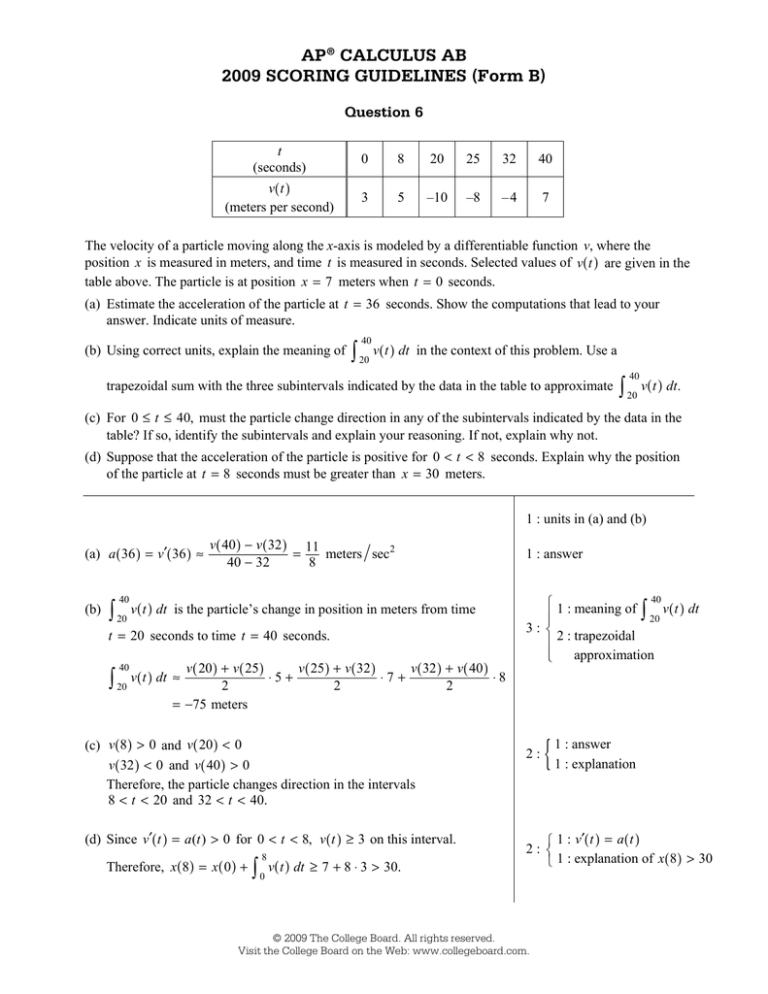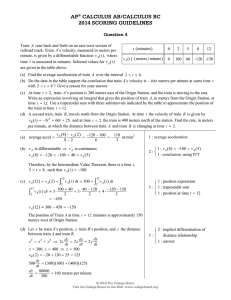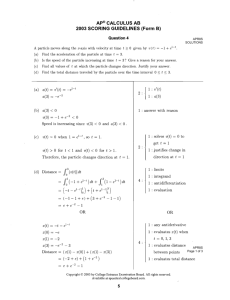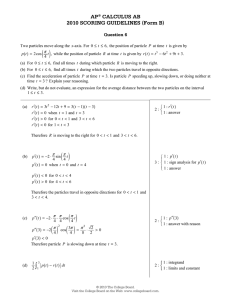Sample Responses Q6 - AP Central
advertisement

AP® CALCULUS AB
2009 SCORING GUIDELINES (Form B)
Question 6
t
(seconds)
0
8
20
25
32
40
v( t )
(meters per second)
3
5
–10
–8
–4
7
The velocity of a particle moving along the x-axis is modeled by a differentiable function v, where the
position x is measured in meters, and time t is measured in seconds. Selected values of v( t ) are given in the
table above. The particle is at position x = 7 meters when t = 0 seconds.
(a) Estimate the acceleration of the particle at t = 36 seconds. Show the computations that lead to your
answer. Indicate units of measure.
(b) Using correct units, explain the meaning of
40
∫ 20 v( t ) dt
in the context of this problem. Use a
trapezoidal sum with the three subintervals indicated by the data in the table to approximate
40
∫ 20 v( t ) dt.
(c) For 0 ≤ t ≤ 40, must the particle change direction in any of the subintervals indicated by the data in the
table? If so, identify the subintervals and explain your reasoning. If not, explain why not.
(d) Suppose that the acceleration of the particle is positive for 0 < t < 8 seconds. Explain why the position
of the particle at t = 8 seconds must be greater than x = 30 meters.
1 : units in (a) and (b)
(a) a( 36 ) = v′( 36 ) ≈
(b)
40
∫ 20 v( t ) dt
v( 40 ) − v( 32 ) 11
=
meters sec 2
40 − 32
8
is the particle’s change in position in meters from time
t = 20 seconds to time t = 40 seconds.
40
v( 20 ) + v( 25 )
v( 25 ) + v( 32 )
v( 32 ) + v( 40 )
⋅5+
⋅7+
⋅8
2
2
2
= −75 meters
1 : answer
⎧ 1 : meaning of 40 v( t ) dt
∫ 20
⎪⎪
3: ⎨
2 : trapezoidal
⎪
approximation
⎩⎪
∫ 20 v( t ) dt ≈
(c) v( 8 ) > 0 and v( 20 ) < 0
v( 32 ) < 0 and v( 40 ) > 0
Therefore, the particle changes direction in the intervals
8 < t < 20 and 32 < t < 40.
(d) Since v′( t ) = a (t ) > 0 for 0 < t < 8, v( t ) ≥ 3 on this interval.
Therefore, x( 8 ) = x( 0 ) +
8
∫ 0 v( t ) dt ≥ 7 + 8 ⋅ 3 > 30.
2:
{
1 : answer
1 : explanation
⎧ 1 : v′( t ) = a ( t )
2: ⎨
⎩ 1 : explanation of x( 8 ) > 30
© 2009 The College Board. All rights reserved.
Visit the College Board on the Web: www.collegeboard.com.
© 2009 The College Board. All rights reserved.
Visit the College Board on the Web: www.collegeboard.com.
© 2009 The College Board. All rights reserved.
Visit the College Board on the Web: www.collegeboard.com.
© 2009 The College Board. All rights reserved.
Visit the College Board on the Web: www.collegeboard.com.
© 2009 The College Board. All rights reserved.
Visit the College Board on the Web: www.collegeboard.com.
© 2009 The College Board. All rights reserved.
Visit the College Board on the Web: www.collegeboard.com.
© 2009 The College Board. All rights reserved.
Visit the College Board on the Web: www.collegeboard.com.
AP® CALCULUS AB
2009 SCORING COMMENTARY (Form B)
Question 6
Sample: 6A
Score: 9
The student earned all 9 points. Note that in part (b) students could include units in either the numerical answer or the
verbal description. The student’s use of “total” is not necessary.
Sample: 6B
Score: 6
The student earned 6 points: the units point, 1 point in part (a), 2 points in part (b), no points in part (c), and
2 points in part (d). In part (a) the student’s answer is correct. The use of an equality sign instead of an
approximation symbol was ignored. In part (b) the student did not earn the point for the meaning of the definite
integral, because the response uses “distance” instead of net distance. The student earned 2 points for the
trapezoidal approximation; the use of L instead of v was ignored. In part (c) the student has only one correct
interval, and the justification is inconsistent with that correct interval. The student was eligible for a point only if
the justification matched the correct interval. In part (d) the student’s work is correct. The verbal argument notes
that the velocity is increasing, implies that v( t ) ≥ 3 on the interval, and argues from the initial position plus
distance traveled.
Sample: 6C
Score: 4
The student earned 4 points: no units point, 1 point in part (a), no points in part (b), 2 points in part (c), and 1 point in
part (d). In part (a) the student’s work is correct. In part (b) the student does not include units and is not using a
trapezoidal approximation. In part (c) the student’s work is correct. The student was not required to describe the
nature of the sign changes in v( t ) . In part (d) the student earned the first point. There is no valid explanation as to
why the definite integral is more than 23. The student needs to appeal to the fact that v( t ) ≥ 3 for 0 < t < 8.
© 2009 The College Board. All rights reserved.
Visit the College Board on the Web: www.collegeboard.com.




